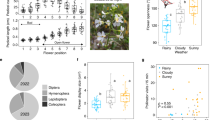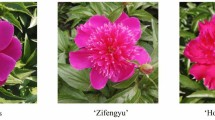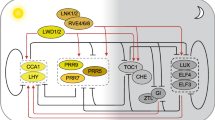Abstract
EFFORTS to induce flowering in the short-day plant Xanthium pensylvanicum under long-day conditions have consistently failed up to now. From numerous reports it has been concluded that for flower induction a short photoperiod must be followed by a long night. The role of the short photoperiod seems to be the photosynthetic production of energy substrates, since it can be substituted for it by sugar treatment1. An uninterrupted long dark period of 9 hr. or more is considered to be necessary to build up a minimum amount of ‘flower stimulus’. However, in Perilla, also a short-day plant, the long-night requirement was alleviated by exposing the plants to a low light-intensity during the day2. Furthermore, a low-temperature treatment during part of the long photoperiod was found to promote flowering (Wellensiek, private correspondence). Thus it appeared worth while to study the effect of low light-intensity and of low temperature during a long photoperiod on the flowering response in Xanthium.
This is a preview of subscription content, access via your institution
Access options
Subscribe to this journal
Receive 51 print issues and online access
$199.00 per year
only $3.90 per issue
Buy this article
- Purchase on SpringerLink
- Instant access to full article PDF
Prices may be subject to local taxes which are calculated during checkout
Similar content being viewed by others
References
Liverman, J. L., and Bonner, J., Bot. Gaz., 115, 121 (1953).
Zeeuw, D. de, Proc. Kon. Ned. Akad. Wetensch. Amsterdam, C, 56, 418 (1953).
Salisbury, F. B., Plant Physiol., 30 (4), 327 (1955).
Author information
Authors and Affiliations
Rights and permissions
About this article
Cite this article
ZEEUW, D. Flowering of Xanthium under Long-Day Conditions. Nature 180, 558 (1957). https://doi.org/10.1038/180558a0
Issue date:
DOI: https://doi.org/10.1038/180558a0
This article is cited by
-
Time measurement and the light period in flowering
Planta (1965)
-
Unterschiedliche Schwankungen der Temperaturempfindlichkeit bei Lang-und Kurztagpflanzen (Versuche zur Bl�tenbildung)
Die Naturwissenschaften (1960)



